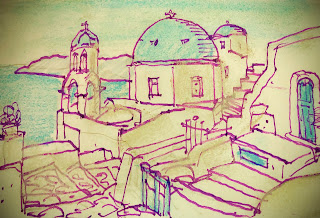Pure color at work
 |
| Venetian North Star - a fresco to honor my father |
I first became infatuated with the great Italian fresco cycles on my 1983 sojourn in Italy. I longed to try my hand at this kind of technique that inspired so many accomplished artists to do their best work and to name a few super stars, Michelangelo, da_Vinci, Fra_Angelico, Ghirlandaio, della_Francesca. There is an abundance of this art all over Italy and many other countries in the world such as Greece, Egypt, India, China and Mexico. Years later and a few more trips to Italy visiting churches and frescoed hallways, I was motivated to find the means to make this a reality for me.
My friend Susan and I were fortunate to inherit some aged lime that is the critical ingredient for this work. This gift we have shared with others in City College classes and in my studio.
This earthy medium speaks to me for I am working smooth, without much texture and the absorption of the color plays a big role. There is a ritual involved too. Aged lime is beautifully white and mixed 50/50 with clean river sand to make the plaster that you can mix with a trowel or your hands. It is then spread smooth onto a panel like icing on a cake. Pure pigments are hydrated with distilled water and you are ready to start.
The first fresco painters used ground natural earth pigments so their color palettes were very limited. The oxides, red, yellow and green were key. Other minerals were finely ground too so that the color would sink down and not sit on top. These were mixed with water and laid onto into a freshly plastered wall where a chemical process would integrate the color and the lime to make it permanent. Drying time, which means working time, would depend on the weather and the hotter it was, the faster the plaster would dry. I found a good video of a fresco painter working and showing her process, sharing a few key points along the way.
https://www.youtube.com/watch?v=-prAIz0urTE and more background on the art of fresco
http://en.wikipedia.org/wiki/Fresco


Comments
Post a Comment